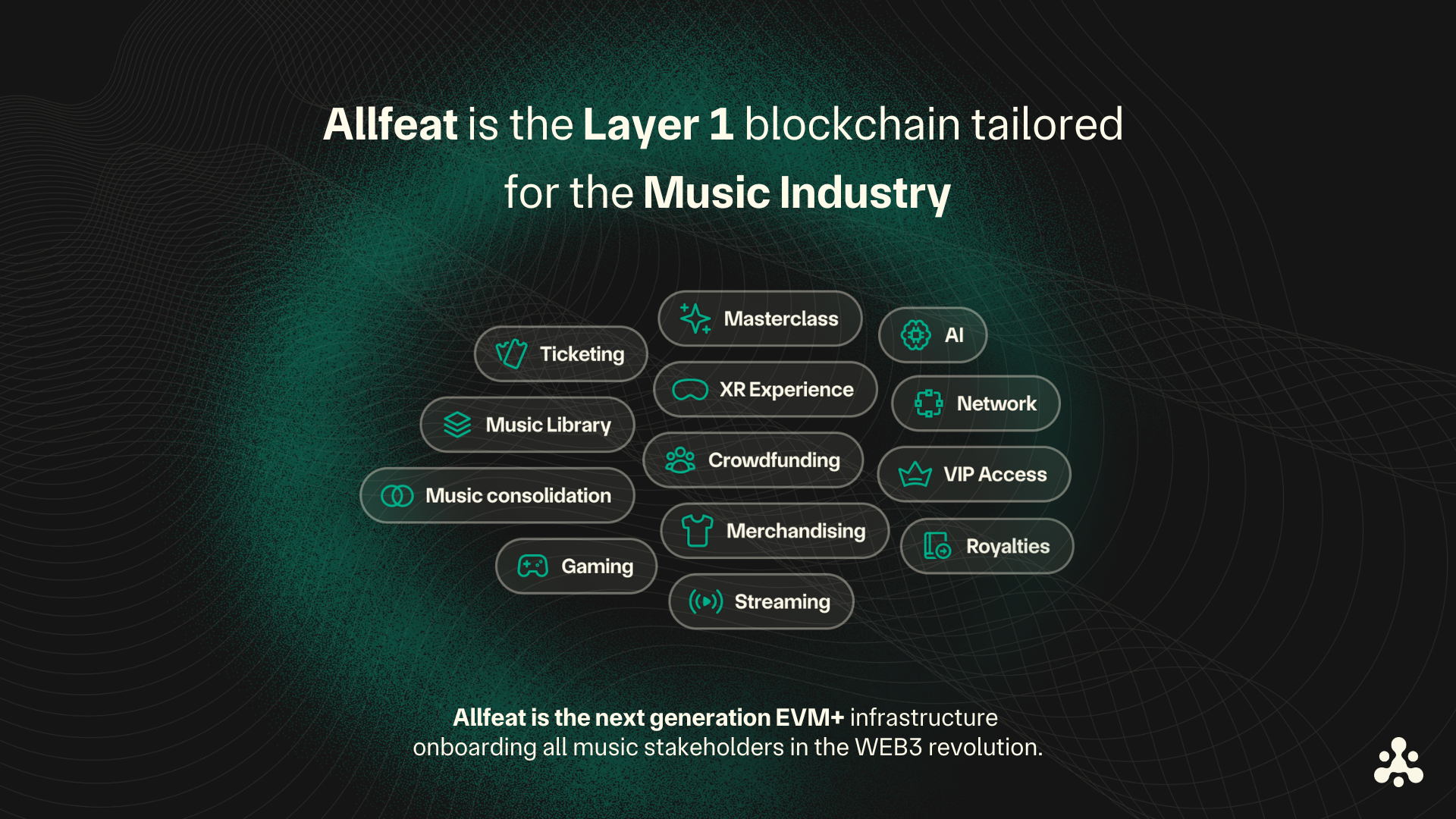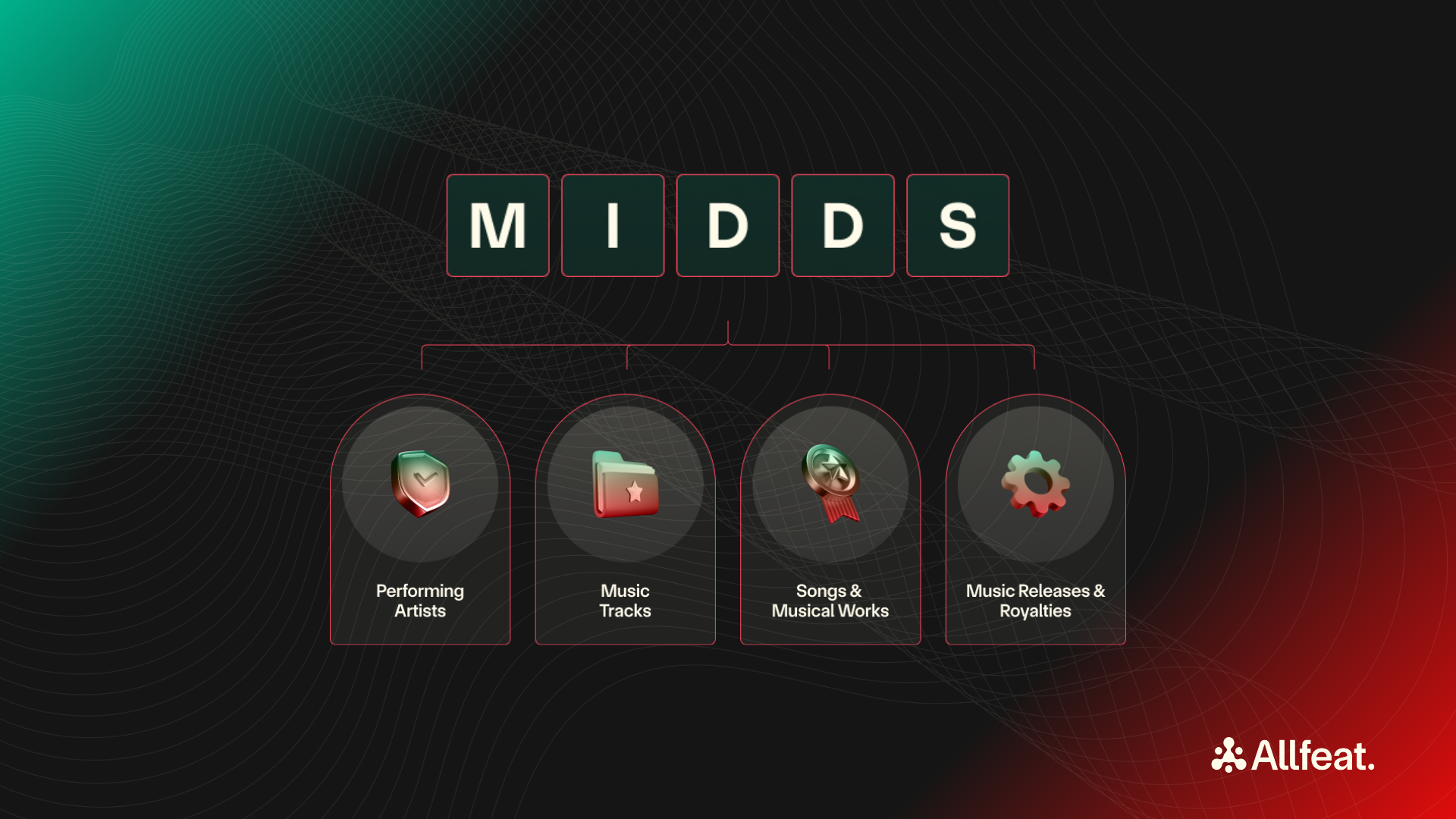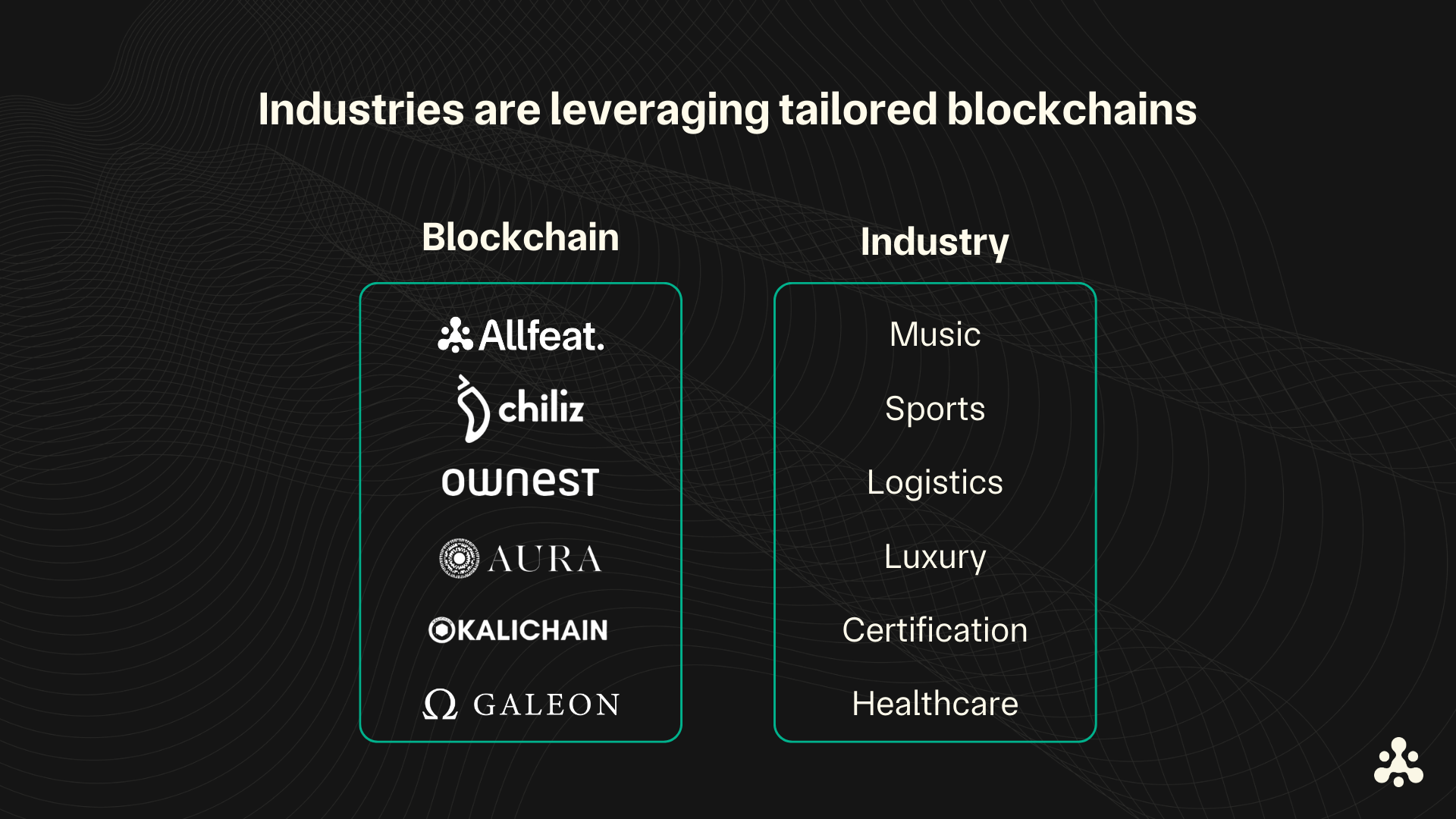Allfeat | The Manifesto

In 2021, a group of friends decided to conceptualize a music platform designed to share & invest in music royalties thanks to IP Tokenization.
After 6 months of development the idea became a proof of concept for “Music Better With You” (MBWY). In 2022, and after months of development and discussion, it became apparent that the music industry was lacking a common blockchain infrastructure emphasizing collaboration between artists and the tech community.
The team decided to pivot and focus on a more efficient and impactful project for the music industry: A layer 1 blockchain.
"Every business idea needs to solve a problem to attract customers"
In 2023, Loïs LAGOUTTE (Chief Technical Officer) and Jean-Christophe BARAT (Chief Executive Officer) understood that music metadata management represented one of the major challenges for the music industry as a whole, with an estimated 25% of royalty distribution being unassigned to music owners. The rise of web3 also emphasized the lack of interoperability of the data between web2 & web3 platforms.
By the end of 2023, and after months of research and consultation with industry experts, our team introduced the MIDDS, Music Industry Decentralized Data Structure, during South by South West (SXSW) 2024 in Austin to the global music industry.
In 2024 Allfeat Foundation was officially founded in Switzerland with a board made of worldwide music advisors. This foundation supports the music industry and the Allfeat blockchain through maintaining a decentralized autonomous organization (DAO) for the community to enforce specific rules set on the blockchain.
Allfeat Foundation’s mission is to support the growth of the Allfeat blockchain and ecosystem. It will also provide marketing support, grants and education material about Allfeat to boost recognition and adoption.
The Idea Behind Allfeat
Building a Web3 application is a real entrepreneurial bet, and finding the most efficient blockchain infrastructure accentuates the challenge.
Allfeat aims at solving this problem by providing a solution customized for the music industry and helping technical builders securely build their innovative ideas. With Allfeat, project founders have access to a chain with a strong technical community working on node validation, tools implementation, and technical proposals for Web3 music use cases.
So, what if the music industry had an open-source protocol and registry helping all developers to build or propose new ways to secure the ownership of the industry?
Empowering Music Use-cases through Web3
Streaming: Leverage NFT technology to access music in a decentralized manner, offering a unique listening experience that gives more control to artists and fans.
Gaming: Music is an important part of a game, so Allfeat can enhance in-game experiences with blockchain technology that securely authenticates and tracks digital assets.
Ticketing: Address widespread issues of fraud in concert ticketing. Using blockchain and NFTs, tickets are purchased securely and can be resold legally. Smart contracts ensure that pricing is controlled by event organizers, reducing scams and counterfeits, while also providing revenue shares to artists.
Monetization & Investment: Fans can invest in IP/Royalty Tokenization of a song or album, and receive a share of future revenues based on the song monetization.
Music catalog: Blockchain technology enhances traceability and proof of ownership, streamlining the process of acquiring music catalogs and ensuring artists and rights holders are properly credited and compensated.
Membership: Blockchain fosters strong communities and increases fan engagement. Fans can earn proof of activity tokens and accumulate rewards, which are backed by real-world assets.
Allfeat Timestamp (ATS): With a simple and decentralized timestamp technology, creators can securely register their original work on the blockchain, providing indisputable proof of ownership.
.aft Domains: These unique domains enable music projects and music actors to establish a distinct presence on the blockchain, such as “my-project.aft” for individual projects, enhancing their visibility and authenticity in the digital space.
Also, an artist domain like “artistname.aft” can redirect to the artist’s comprehensive profile, simplifying access and enhancing visibility within the web3 music community.
Metaverse: In the Metaverse, all goods and tools can be registered on the blockchain, ensuring verifiable ownership and authenticity. Additionally, Allfeat Timestamp technology (ATS) allows for the precise timestamping of songs played within the Metaverse, further enhancing the traceability and rights management of music in virtual environments.
And many more: Blockchain allows the creations of a large number of use cases, redefining the border of music, gaming, finance, and fandom.

When creating the infrastructure, Allfeat's founders imagined a blockchain layer on which to develop applications dedicated to the music industry.
Utilizing a Layer 1 blockchain provides intrinsic security, as it is developed and maintained by the music industry for its specific needs. This infrastructure enables companies and artists to conduct transactions with immutable proof of ownership directly on the blockchain. It empowers stakeholders to manage their own nodes, contributing to a decentralized and robust network. This hands-on interaction promotes a deep understanding of the blockchain, fostering a community-driven approach where industry stakeholders ensure and uphold network security themselves.
We are convinced that the music industry will jump into the Web3 revolution. The question is “where ?”.
What if there were an open-source infrastructure that allows the music ecosystem to build and customize tools and services directly on the blockchain's core? By enabling and proposing code optimizations tailored for the music industry, such infrastructure could accelerate the integration of applications and users, potentially setting new standards in the music web3 landscape.

The Hub for Music Metadata
Music Industry Decentralized Data Structure (MIDDS) are specialized data structures tailored for the music industry, stored and managed on a decentralized network.
They ensure data integrity, transparency, and accessibility while being optimized for performance and scalability. MIDDS encompass various elements, including artist profiles, music releases, or copyright management.
Additionally, MIDDS, as a native feature of the blockchain, offer unparalleled structure storing performance, setting them apart from other EVM and general Layer 1 solutions. This capability is essential for managing complex music industry data effectively.
Music Industry Decentralized Data Structures (MIDDS):
MIDDS are designed to store and manage music metadata in a decentralized manner for the music industry.
Performing Artist: On the blockchain, each Performing Artist's profile includes essential details such as Account ID, registration date, primary and secondary types, genres, a descriptive bio, and associated assets. This setup allows artists to create and manage their profiles directly on-chain.
Music Tracks: Each track metadata will be securely engraved and stored on the blockchain, including ISRC code, track title, production country, lyrics language, audio hash and other associated metadata. Additionally, to verify and protect the authenticity of audio files, the system could use hashes of the music files in various formats and qualities. This approach would enable the matching and verification of original audio files, ensuring integrity and copyright protection in the decentralized environment.
Song & Musical Work: Song metadata will be tracked through the blockchain, ensuring that each content is correctly mapped with the correct ISWC, song title, song IDS, song duration, song type, and other associated metadata.
Music Releases & Royalties: Each release will be easily tracked ensuring a fair and accurate royalty distribution. Utilizing the Music Industry Decentralized Data Structure (MIDDS) natively integrated into the blockchain creates a robust and adaptable copyright system for the Web3 environment. This architecture ensures that each piece of music and its corresponding artist data are securely managed and accurately associated, paving the way for efficient rights management and royalty distribution in the decentralized digital landscape.

You will be able to develop your music project in a stronger, deeper, safer environment.
The Rust & EVM Architecture
In a landscape brimming with over 100 blockchain options, selecting the right foundation for building a Web3 project becomes daunting. Founders often gravitate towards networks riding the wave of hype, buoyed by financial incentives. Our strategy, however, was twofold:
- Rust for the Blockchain’s Core
Choosing the right programming language is crucial for blockchain development, each offering unique features. For us, Rust was the optimal choice due to its robustness, efficiency, and safeness. Notably used by other renowned blockchains, Rust has a proven track record in the ecosystem.
Our team selected the Rust-based framework Substrate, developed by Parity Technologies, which supports a modular approach to blockchain development and facilitates EVM ecosystem integration through Frontier.
Rust skills benefit blockchain developers by improving performance, security, and reliability. Rust's compile-time checks reduce runtime errors, making blockchain applications more robust. Additionally, Rust's expressive syntax and strong community support enhance development efficiency and innovation.
- EVM for the Applications Layer
Since its launch in 2015, Ethereum has been a leader in the blockchain space, noted for its liquidity, large user base, and thriving dApp community. In developing Allfeat, it was crucial to ensure compatibility with the Ethereum Virtual Machine (EVM) to support the broadest range of developers and applications.
Allfeat is an EVM+ blockchain, which not only facilitates easy migration for Ethereum developers using Solidity but also incorporates a robust Rust-based core. The core layer enhances the blockchain's functionality by enabling the addition of native features directly to Allfeat’s infrastructure.
As a result, the EVM layer operates more like the "tip of the iceberg," supported by a powerful Rust core that allows flexible modulation of the blockchain’s capabilities and features, tailoring it to specific needs and innovations.
A blockchain focusing on an industry
Allfeat founders recognized that for blockchain technology to impact industries like music, the focus needed to extend beyond merely offering more efficient code. Rather than striving to outpace Ethereum, they envisioned a platform inherently rooted in the music industry to attract relevant stakeholders. This strategy set Allfeat apart, focusing on industry-specific advantages instead of just technological advancements like new programming languages or smart contracts — a common pitfall for other blockchain projects.
In 2024, Forbes qualified 20 blockchains as “crypto zombies”, among them some with the highest market capitalization.

Conclusion
Allfeat represents the next generation of EVM+ layer 1 blockchain networks, specifically designed for the music industry. It hosts decentralized applications (dApps) through smart contracts, enhancing functionalities with an industry-focused software development kit (SDK).
The platform includes a robust Decentralized Autonomous Organization (DAO) tailored for music sector engagement, ensuring all users have a voice in governance. Allfeat’s SDK simplifies the development of blockchain applications that cater to music-related use cases, making it a pivotal tool for developers and validators alike.
You want to learn more about Allfeat and how to build a music blockchain application? Visit docs.allfeat.com.
Additionally, connect with our growing community and dive deeper into the world of music in Web3 by joining our Discord server here.
